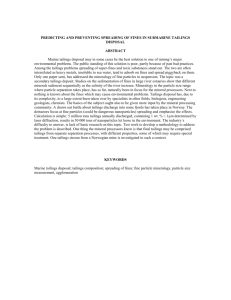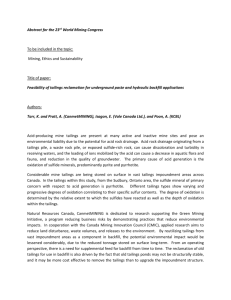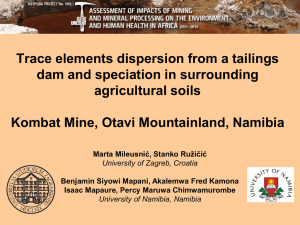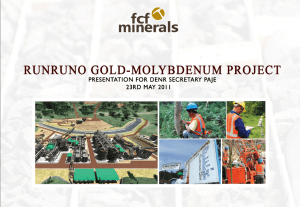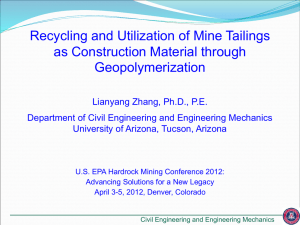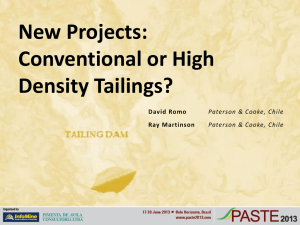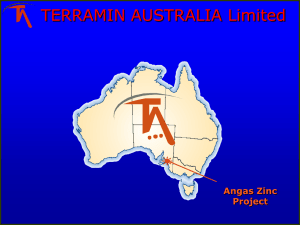Dry Stacking of Cycloned Tailings.
advertisement
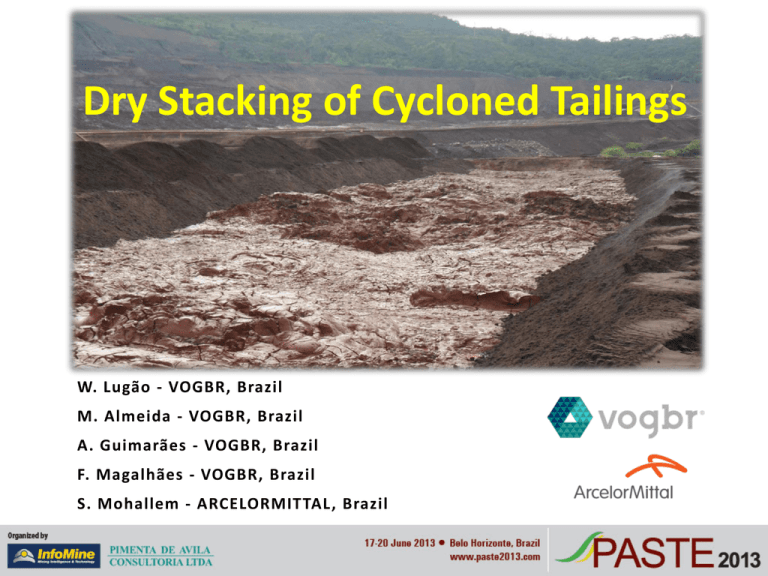
Dry Stacking of Cycloned Tailings W. Lugão - VOGBR, Brazil M. Almeida - VOGBR, Brazil A. Guimarães - VOGBR, Brazil F. Magalhães - VOGBR, Brazil S. Mohallem - ARCELORMITTAL, Brazil Introduction Tailings at ArcelorMittal Mineração’s Serra Azul Mine are currently disposed of in a tailings dam, which is at the end of its useful life. Another tailings disposal facility is required and there is no place for another conventional dam. A drained stacking scheme was proposed, with the following advantages over conventional dams: - It allows tailings to be stored in stacks, which poses less risk as it does not involve the storage of water; - It will be located in an area that was occupied by a fines stockpile (sinter feed), which is why no additional land will have to be purchased; - It allows mining operations to proceed without interruption. IMAGE: 09-14-2007 – GOOGLE EARTH SERRA AZUL MINE TAILINGS DAM SINTER FEED IMAGE: 07-30-2011 – GOOGLE EARTH SERRA AZUL MINE TAILINGS DAM DRY STACKING TAILINGS Design Concept DRY STACKING DRYING PONDSOVERFLOW TAILINGS CONTAINMENT DIKE SEDIMENT CYCLONE Design Concept A WASTE/TAILINGS CO-DISPOSAL WASTE PILE DRY STACKING Design Concept INTERNAL DRAINAGE DRAIN - SECTION JIG TAILINGS ROCK-FILL STARTER EMBANKMENT Design Concept A Example: Plant level 1,030 m – tailings/waste co-disposal SECTION A WASTE PILE UNDERFLOW TAILINGS JIG TAILINGS OVERFLOW / UNDERFLOW TAILINGS 8m 25m 100m ROCK-FILL STARTER EMBANKMENT TAILINGS CELLS Design Concept Schematic profile (section A) OVERFLOW/UNDERFLOW UNDERFLOW DIKES ROCK-FILL STARTER EMBANKMENT JIG DIKES WASTE PILE Design Concept UNDERFLOW DIKES Conception: Underflow dikes – vertical drainage!!! Conception: Overflow – drainage in top and base!!! Pilot Tests – Total Tailings Pilot Tests - Cyclone UNDERFLOW TAILINGS CYCLONE Percent finer than Tailings characterisation Jig Tailings Total Tailings AM01 Underflow AM02 Underflow Overflow Grain size - millimeters Table - Test results Full gradation Table - Sample SG Total tailings Compaction woptimum rmax (g/cm³) (%) Void ratio emax emin - - - - - 1.01 0.71 0.2 - - 1.09 0.77 15.6 0.0 13.0 2.208 - - 65.5 29.3 - - - - Clay (%) Silt (%) Sand (%) Gravel (%) 3.717 4.4 60.9 34.7 0.0 - AM-1 Underflow 3.741 1.8 30.6 67.4 0.2 AM-2 Underflow 3.838 1.4 33.6 64.7 Overflow 3.405 7.2 77.2 Jig 3.544 0.2 5.0 Permeability test summary Re-moulding conditions Sample Relative compaction (%) Degree of compaction (%) Permeability (m/s) Moisture (%) rdry (g/cm³) 11.6 2.039 1.10e-06 11.7 2.038 1.40e-06 12.8 1.878 4.20e-08 AM-1 Underflow 60 AM-2 Underflow 70 Overflow - 85 Table 6 Parameters for materials used in stress-strain and stability analyses Table - Triaxial test results Effective strength parameters Sample Table - Total strength parameters c’ (kPa) f’ (°) c (kPa) f (°) AM-1 Underflow 3.89 29.7 0 26.5 AM-1 Underflow 5.00 31.2 17.20 18.7 Overflow 4.05 30.1 5.20 11.6 Parameters for materials used in stress-strain and stability analyses Material Density (kN/ m³) c’ (kPa) f’ (°) Deformation modulus (MPa) n (Poisson’s ratio) Foundation 17.0 15 28 20,000 0.20 Rock-fill 23.0 0 42 80 0.25 Underflow 22.8 0 30 20 0.30 Overflow 20.0 2 26 4.0 0.40 Jigue 23.0 0 36 27.5 0.25 Waste 22.0 0 34 40 0.33 Stress-strain analysis MATERIALS FINITE ELEMENT MODEL (SIGMA) FINAL STACK CONDITION Stability Analyses The safety factor for the critical failure surface is 1.97 and is therefore satisfactory. Stability analysis results for waste rock/tailings co-disposal – Global – Non-Circular failure. Operation OVERFLOW TAILINGS – DISPOSAL SEQUENCE Building the tailings cells Situation - December 2012 DRYING PONDS ROCK-FILL STARTER EMBANKMENT CONTAINMENT DIKE UNDERFLOW LEVEL 1000.5 m OVERFLOW LEVEL 1000 m Final Remarks •Stability analyses have arrived at a satisfactory safety factor, assuming the long-term (drained) final stack condition; the maximum predicted subsidence in dry stacks will be acceptable even in the most critical long-term condition; •It is suggested that the cyclone system operating techniques should be reviewed, as the system is now working with overflow rates in excess of design rates. As a result, underflow requirements are being filled with jig tailings currently available at the mine for such purpose. •It is also recommended that alternative methods should be developed for carrying overflow tailings from dewatering ponds to the storage basins, including alternative deposition methods, with a view to improving the process which is currently undertaken using trucks. • An investigation campaign is programmed, composed of SPT, CPTU, Vane, permeability and laboratory tests; • ArcelorMittal will continue monitoring the performance of the system. Thank you! Contact: wlugao@vogbr.com.br
